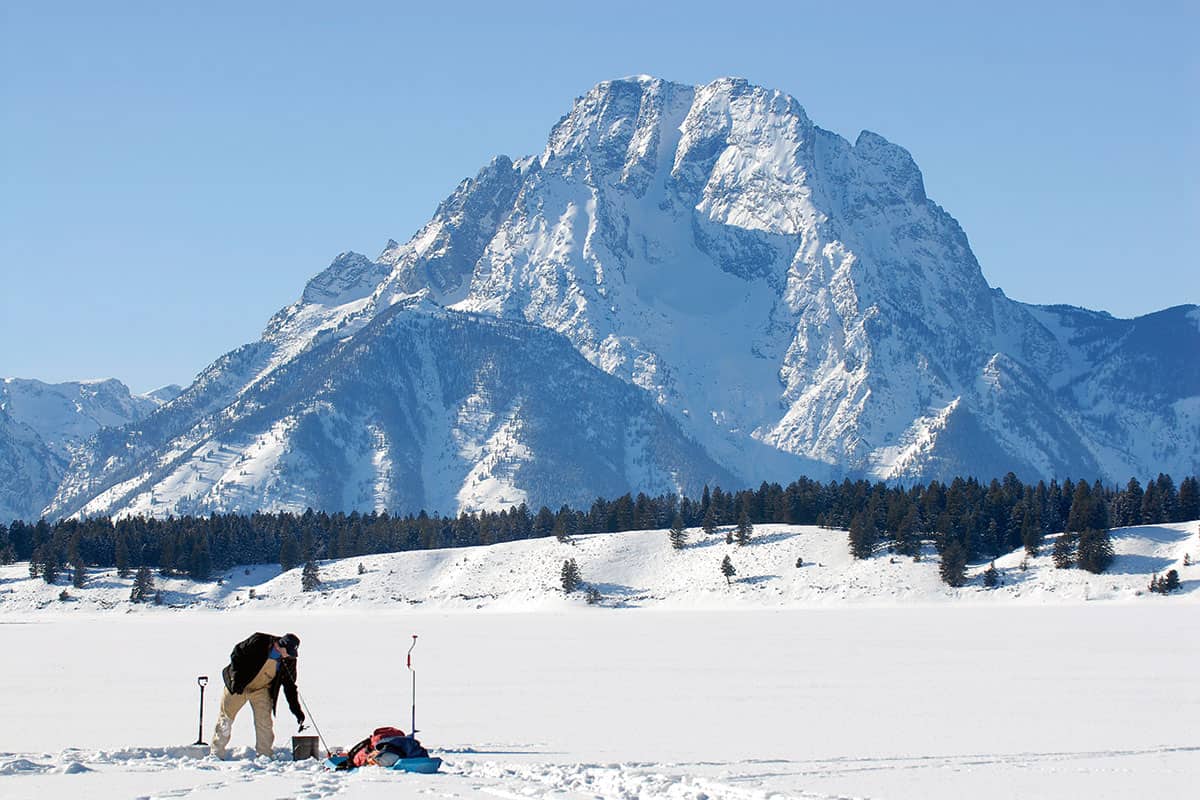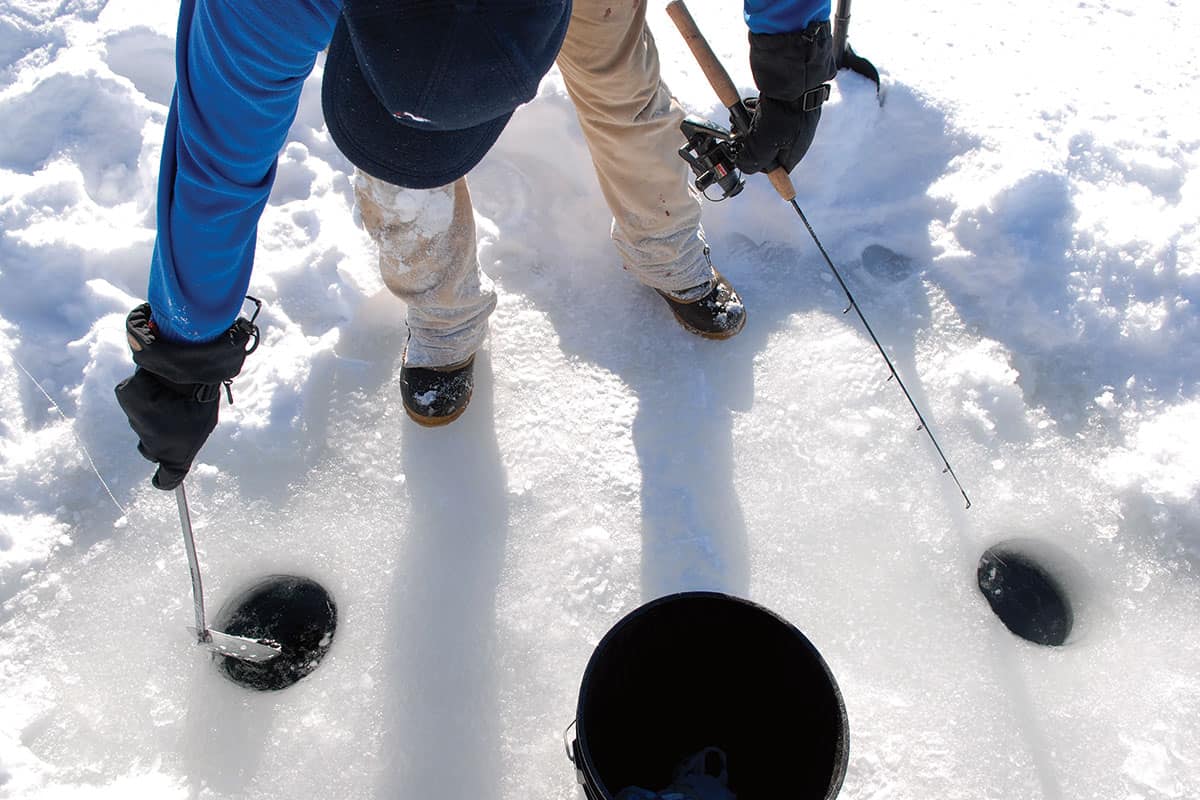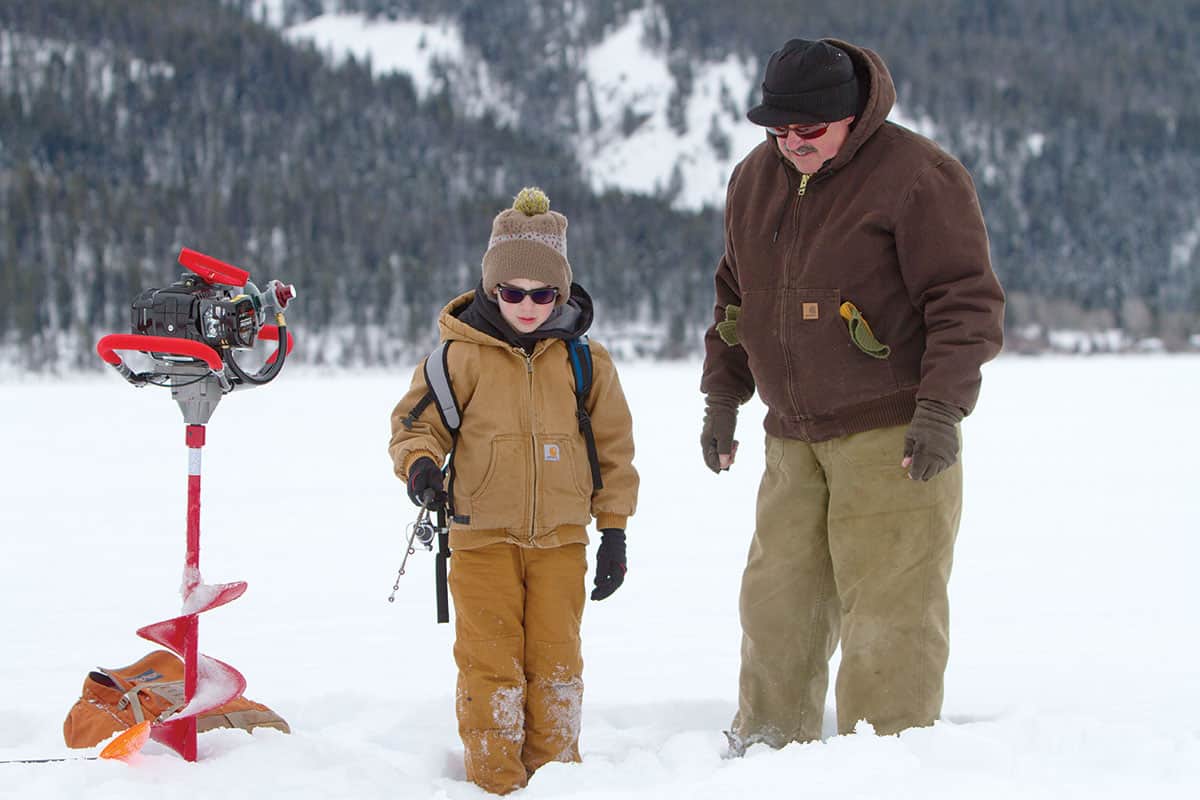Read The
Current Issue
Drilling for Fish, Teton-Style
Ice fishing’s glory days in Jackson Hole have passed, but this unique brand of angling still persists.
By Mike Koshmrl

THE PROSPECT OF standing on two feet of barren ice, peering down into an eight-inch hole in the grip of frigid temps and hoping for the best, became more alluring to Chris Colligan when he had few other options. A backcountry snowboarder who has taken on seldom-carved lines in places like Mount Moran, the native Michigander was raised ice fishing. In his early years in Jackson, he occasionally pursued trout atop a frozen lake, but never made it a regular part of his life. Then, he fell while snowboarding and tore the ligament connecting the bones of his thumb. (Its severity became clear when Colligan couldn’t hold a drink.) The injury would necessitate surgery, and derail his season on the slopes.
… think old men sitting on a five-gallon pail, bored and bickering, with a light domestic beer in hand just as often as their fishing rods. But ice fishing in Jackson Hole is vastly more interesting than that.
“I joked about it. I had a pin going through my thumb, and I called it my lake trout detector,” says Colligan, a decadelong valley resident who works in the conservation nonprofit world. “It was supercold fishing with that piece of metal going into your thumb and your bone.” The hardship aside, a couple months of heavy time on the ice hooked him onto Jackson Hole’s underappreciated ice-fishing opportunities.
After his thumb recovered, Colligan had a hard decision to make: hit the ice or the slopes? Diversifying the contents of his game-filled freezer played into the transition as well. “Somebody asked me recently if I wanted to go in on free-range sustainable salmon from Alaska,” Colligan says. “Why, when I’ve got smoked lake trout? Catch a brown trout out of Jackson Lake in the winter, and you have a hard time telling the difference between that and Atlantic salmon. We can it, we smoke it, we cook it all different ways.”

FOR THE TYPICAL valley resident and visitor, ice fishing is lost in the shuffle of wintertime activities: downhill, backcountry, cross-country and skate skiing, along with snowshoeing, snowmobiling, and even fat biking. Perhaps the caricature of the sport in the Midwest, where shanty towns appear on frozen lakes and it’s big business, doesn’t help its popularity: think old men sitting on a five-gallon pail, bickering and bored, with a light domestic beer in hand just as often as their fishing rods. But ice fishing in Jackson Hole is vastly more interesting than that. Plunking a silver spoon or jig head into the icy waters of Jackson and Lower Slide lakes is a wintertime activity that’s steeped in history, unites families and friends outdoors in beautiful places, and—if you know where and when to carve out a hole and what to tie on the line—can make for top-notch fishing.
“I look forward to it more than any other type of fishing that I do,” says Andy Asadorian, a Victor, Idaho, resident and WorldCast Anglers guide. “And I’ll fish for anything, with any rod.” To Asadorian, there’s a mystique about spending a day on top of a frozen lake at the base of the Tetons. The typical outing for the fishing guide is a social one, complete with good eats—the freshest of fish tacos have been had. But he also has days of solitude. There have been plenty of winter days on Jackson Lake, the most popular of local ice-fishing spots, where he hasn’t seen one other angling party.

THE POPULARITY OF ice fishing in the valley has dwindled over the decades. Two primary developments have dampened local participation: the evolution of cold-weather fly-fishing gear and Grand Teton National Park’s 2003 prohibition of “snowplanes” on Jackson Lake.
The former allows anglers to stay warm(er) while plying always-open rivers with nymphs and streamers. Now, even in the depths of winter, you can fish places like the Snake and its South Fork. “Neoprene waders came out and changed the whole game,” valley resident and avid ice angler Joe Burke says. “Before, you’d get out there and you wouldn’t be able to feel your feet for a week.” The snowplane prohibition addressed vehicles that aren’t aircraft in the conventional sense. In the second half of the twentieth century—the valley’s ice-fishing heyday—more than one hundred of the propeller-driven tracked vehicles had permits to cruise over the frozen surface of the fifteen-mile-long body of water.
The snowplanes were tightly tied to ice fishing, recalls Wyoming Game and Fish Department regional fisheries supervisor Rob Gipson. “They were only used to fish,” Gipson says. “I don’t know of anybody who used one for just tooling around.” After the snowplane ban thirteen years ago, the Jackson Lake ice-fishing scene “didn’t have the same feel,” Gipson says. Snowplaners, oftentimes Idahoans and residents of elsewhere in Wyoming, stored their machines, along with campers, at Colter Bay for the season. They drove to Jackson Lake and stayed most weekends, snowplaning from fishing hole to fishing hole during the day and recovering in their campers at night. Jackson Lake ice fishermen can still use snowmobiles to move around (fishing access is the only acceptable use of snowmobiles on the lake) but it seems that part of the appeal of ice fishing there was the novelty of using a snowplane to move across the lake. Most of the former snowplaners stopped ice fishing rather than switch to sleds.
DESPITE THE RELATIVELY slim crowds out on the ice nowadays, the fishing can be stellar. “I think it’s world-class,” Asadorian says. While that description may be Homer-driven hyperbole, fisheries biologists confirm that the lake trout (mackinaw) are available for the taking. The limit is six, with no more than one measuring over twenty-four inches. Averaged across all of last winter on Jackson Lake, anglers hauled in about 0.6 lake trout an hour—not gaudy, but enough action to keep fishermen on their toes.
Diana Miller, the Game and Fish Department fisheries biologist in Gipson’s old job, says the groups she checks in on out on the ice are a mix of families and old-timers, mostly nearby Star Valley and Idaho residents who grew up ice fishing. “It’s definitely a certain breed of person that wants to go sit out on the ice all day,” Miller says. “I’ll go occasionally, but usually I like to ski as much as I enjoy fishing.” Commercial ice fishing in this corner of Wyoming is nonexistent, so everybody is a do-it-yourselfer. “They don’t really have a whole lot of doodads,” Miller says. “Generally it’s just kind of the crowd that’s been doing it their whole lives, and they have their tried-and-true reel and rod and stick with it.”
Run into someone on the ice and there’s a good chance it’ll be a longtime Jackson Hole ice fisherman who can teach you some tricks of the trade, which are not given up willy-nilly. Several old-timers I reached out to declined to be interviewed, not wanting to disclose their secrets.
To the most fanatical of ice anglers, the sport can be gear-intensive and a drain on the wallet. Peruse a Cabela’s catalog and you’ll find an impressive collection: powerful and pricey ice augers, underwater cameras, fish-finding sonar, ice-fishing-specific rods and reels, and accessories ranging from an “outdoors portable beverage holder” to ice chaps and portable heaters. It wasn’t always such a gear-intensive endeavor, Burke recalls. “We used to get a couple of sticks off the shore and stick them in the hole so we could see where it had been the week before,” he says.
Plenty of local anglers eschew high-tech gear. All it takes, essentially, are warm clothes and a summer spin-fishing setup. In the absence of an auger, anglers can punch open holes that were carved out in recent days. No boat, of course, is necessary. Colligan had a power auger early in his ice-fishing days, but retired it in favor of a simpler and lighter hand-cranked device. “I like to incorporate a little exercise into it,” he says. “Taking skis and using a hand auger, going kind of light and getting out there is the way we like to go. At the end of the day you’re whooped, just like you would be if you skied all day.”
Once Grand Teton National Park’s interior road gets plowed out in spring and is open to bikes (but not cars), Colligan has cycled to ice fish on smaller lakes along the base of the range. (This usually happens the second half of March.) On one outing at “zero dark thirty” this past year, he hooked into and landed a three-foot-long mackinaw on a semibroken and lightweight rod that was barely up to the challenge. The fight took ten minutes. “I was a little undermatched for it,” Colligan says. “You hook into something like that and it feels like a log and it’s pulling line out of the reel. They fight hard, especially in the winter, and especially when you’re trying to get them through an eight-inch hole.”
ON OTHER OCCASIONS, Colligan’s had epic fights not with fish but with the elements. There’s the biting bitter cold and blinding, blowing snow that can produce the same disorienting effect skiers tackle on top of the aerial tram at Jackson Hole Mountain Resort. Rare wintertime thunderstorms have caused his fishing rods to buzz with static electricity, and on more than one occasion Colligan has broken through the ice in the early season. Frozen pants on such days, he says, feel like you dressed yourself up in stovepipes. “There’s an adventure element to it that I guess people probably don’t understand,” he says.
While Jackson and Lower Slide lakes are the only viable drive-up ice-fishing options in the valley, for those with a willingness to glide or tromp over the snow to get there, there are more choices, like Jenny, Phelps, and Leigh lakes. Lakes holding only Snake River fine-spotted cutthroat are best avoided, because the native trout species is notoriously apathetic about eating under the ice. But there are plenty of lakes with lake trout, a species that was introduced here and that tends to remain active and forage through the winter. Lakes on the east slope of Togwotee Pass like Torrey Lake and parts of the Brooks Lake watershed and the Finger Lakes at the western base of the Wind River Range are mackinaw fisheries. If you want to be part of a true ice-fishing scene, drive five hours to Flaming Gorge or Boysen reservoirs, where there are some warm-water species in addition to trout, and plenty of other anglers around. If you have a snow machine, Green River and Grassy lakes are options and have solid stocks of trout. Yellowstone’s Lewis, Shoshone, and Yellowstone lakes are fishable, but because of the scarcity of wintertime permits authorizing solo snowmobile access into the park, anglers are rarely seen on the ice of these lakes.

IN ADDITION TO the physical exertion that can be had by adopting the Jackson Hole brand of ice fishing, there’s the serenity. “It’s so peaceful out there,” Asadorian says, “and it’s beautiful.” Colligan’s drawn to those same qualities. “You have this whole lake, seemingly to yourself,” he says. “It’s pretty quiet on Jackson Lake and, really, any of the lakes in the winter. The few ice fishermen that go through are probably the only people they see at the entrance station some days.”
Run into someone on the ice and there’s a good chance it’ll be a longtime Jackson Hole ice fisherman who can teach you some tricks of the trade, which are not given up willy-nilly. Several old-timers I reached out to declined to be interviewed, not wanting to disclose their secrets. They were sad there was an article being written about ice fishing at all—most see the activity in general as secret.
To Asadorian, there’s little to worry about when it comes to keeping competing fishermen away from his favorite holes. “There’s plenty of room for growth in ice fishing,” he says. Burke, a retiree and avid volunteer who’s involved with the 4-H Sportfishing Club, is part of an effort to turn the next generation on to the sport. Annual winter trips to Lower Slide Lake have exposed a number of Jackson Hole youth to the patience-stretching endeavor. “The kids have fun just playing up in the hillsides,” Burke says, “until one fish gets hooked, and they’re all right back down there on the ice.”




